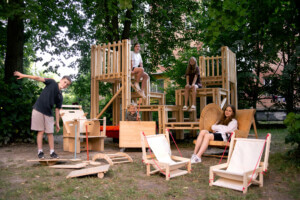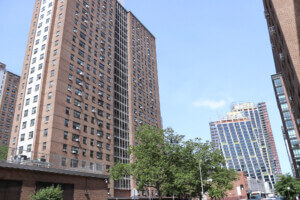The Center for Architecture is known for programming variety, but last Thursday night’s premier of Architect: a chamber opera was a first. Granted, the film premier benefiting the CFA Foundation wasn’t live opera, but it was the first time the public got to hear the piece by Lewis Spratlan. The Pulitzer Prize winning composer’s music was paired with electroacoustical music by John Downey and Jenny Kallick, whose process involved “sound sampling” spaces designed by Kahn, such as the Salk Institute in La Jolla, California. Spratlan’s music was then electronically “placed” within the various spaces.
For all the electronic bells and whistles, the piece is fairly traditional, albeit inflected with modernist leanings. Classic operatic devices could be found throughout, particularly in the character of a trickster god called Momus, a minor deity thrown off Olympus. The trickster morphs into the Guide, the Engineer, and the Healer, all of who conspire to get the architect away from the Woman, in order to create buildings that flatter the gods. Given Kahn’s unconventional personal life–various children from various lovers and a tragic demise at New York’s Penn Station–playing off the personal drama would seem an obvious choice. Instead, the team obliquely focused on the architect’s struggle to realize his vision, opting for a universal theme that transcended the medium and artist.
The film intersperses relatively few images of Kahn’s buildings with watercolors by artist Michiko Theurer. and photographs of Rome’s crumbling ruins, partly inspired by Edgar Alan Poe’s poem, “The Coliseum“. Even images of Gaudi’s “La Sagrada Familia” find their way into the cross fades. The creators traveled to Eternal City, to several Kahn buildings, and worked together at Yale where the architect’s Art Gallery and Center for British Art loomed over the process.
For opera designer John Conklin the work evoked Debussy’s Pelléas et Mélisande. Kallick’s libretto eschewed archi-speak in favor of conversations between Kahn and his collaborators, such as this statement to the Engineer: “Dear August [Komendant] why does everyon pull me down?” “You are a dreamer not a fighter,” replies the engineer. This kicks off an ode to concrete duet, that’s clearly the opera’s show-stopper: “Mix and cure it with the right vibration,” goes the oft repeated refrain. And finally, the words every engineer wants to hear from an architect: “Your genius has made my buildings your buildings.”
Part of what makes Architect intriguing is the colaborators cross polinization into other fields. Spratlan wanted to be an architect before becoming a composer, Theurer is trained as a violinist, and Downey is studying radiology at Stanford. Later during the panel discussion, Kahn’s daughter Sue-Ann Kahn, said that the piece was an allegory for any artist’s struggle. “Either the gods are helping them or crushing them,” she said.
Having Conklin on hand turned the post-screening panel into a virtual workshop. Conklin, having seen the video before, simply listened to the piece apart from the imagery. He said that while the ethereal images worked well on video, live opera was another matter. He thought much of the abstraction could be retained, but he envisioned scenes between the Architect and the Woman played in a banal kitchen. He also suggested bringing the small orchestra, there are only seven players, onto to stage to become part of the action.
The video will be released with the CD in Spring 2012 and the creators hope to perform the production live at a Kahn-designed site. The idea intrigued AN’s editors, who suggested Dacca, the more cost and acoustically effective auditorium at the Yale Center for British Art, or at the new Four Freedoms Park performed by the homeless City Opera. As Sue-Ann Kahn pointed out during the panel discussion, the delayed memorial exemplifies the artist’s struggle to see their work realized.










